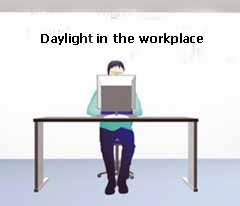
daylight in the workplace
A key measure is the illuminance in lux
Occupational physicians have identified a minimum illumination of 500 lux for the office workplace. In comparison, the illuminance outdoors are much higher. Even on a cloudy autumn day 5,000 lux can be achieved. With an overcast sky in the summer of 20,000 lux are to be expected and when the sun shines even 100,000 lux. The lighting design jobs should not go out from the optimal condition outside, but must also at lower light levels provide plenty of natural light in the interior.
A daylight factor of 3% as the minimum value
The daylight factor is the ratio between the light intensity indoors and outdoors. If, in the interior 500 lux expected, then there must be at a daylight factor of 3% a brightness outdoors of almost 17,000 lux. It must be accepted that this requirement is not achievable any time in the year.
The ratio of window area to the base
In areas with increased vision needs, this includes office space, is the ratio of light transmitting surface and the bottom surface of the room be 1: 5. For example, a room has a floor area of 18 square meters. Then the translucent surface must be 3.6 m2. From the pure opening dimensions of the wall are still the surfaces of the window frame to be deducted. To improve the illumination of the desk should be as close to the window. A shift toward the center of the room, the light intensity deteriorated considerably.
Other factors affecting the illuminance at the workplace
When planning the orientation of the building must be observed. The north, north-east or north-west side can be expected to lower light levels than the south, east or west side. Near the building opposite or high and densely overgrown trees shade the work rooms. Balconies or cantilever plates over the windows reduce the incidence of light also. Sun and heat protective glazing not only reduce the incidence by 40% to 50%, but can also affect the light spectrum and thus the color perception. Of course, the windows should be clean and not interfere with thick curtains. Contrast, bright interior surfaces improve the light intensity.
Visual connection to the outside improves the well-being
The lack of visual contact to the outside gives a bunker effect. The conscious perception of the environment, however, promotes well-being. Especially perceived the course of the day, weather changes or events in the environment. Too high window sills or narrow passages obstruct the view to the outside.
Meters
The illuminance to 100,000 lux can already compete with cheap instruments that cost less than 100 EUR. If, in addition still flickering in percent and the dominant flicker frequency being measured are to be estimated costs of 500 EUR. An additional data logger function is in the price range around 800 EUR available (www.merkel-messtechnik.de).
Professional illuminance measurements according to DIN 5032 require higher effort. These temporal and multi-point averages are to be calculated in order to determine the average illuminance of a room or a job (www.testo.de).
